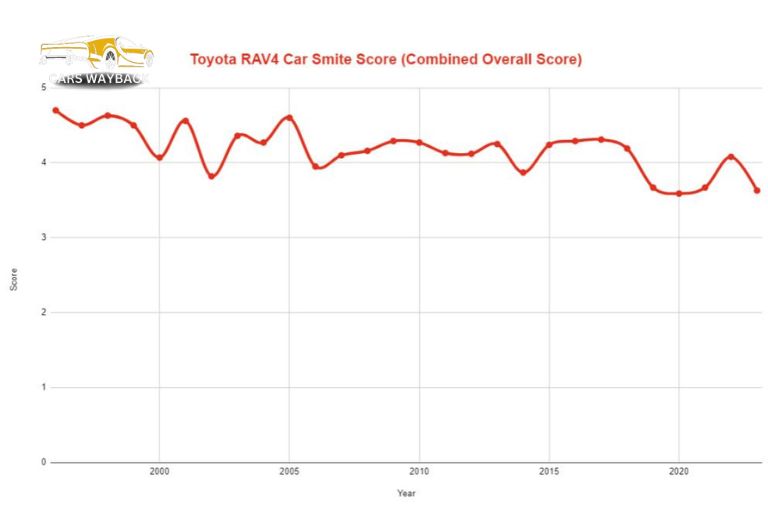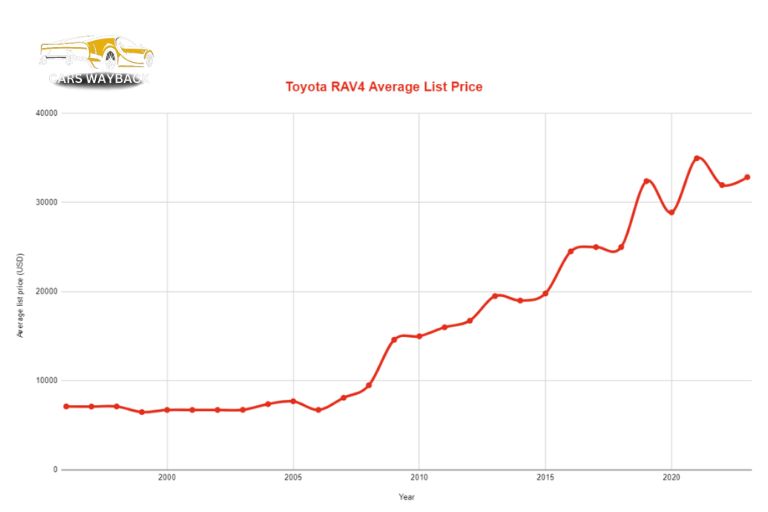The Toyota RAV4 has long been a staple in the compact SUV market, offering a blend of reliability, versatility, and comfort. But not all model years are created equal. In this comprehensive guide, we delve into the best and worst Toyota RAV4 years to help you navigate the sea of options and make an informed decision when shopping for this iconic vehicle.
You’re looking for cutting-edge features or tried-and-true durability, understanding the nuances of each year’s production can be the key to finding your perfect match. So buckle up as we take a thrilling ride through the evolution of one of Toyota‘s most popular models and uncover which years shine brightest and which ones fall short in the ever-evolving world of automotive excellence.
Best and Worst Toyota RAV4 years of Generations
The Toyota RAV4 has won the hearts of countless drivers around the world since its inception in 1994.
| Generation | Years |
|---|---|
| Toyota RAV4 (1st generation) | 1996-2000 |
| Toyota RAV4 (2nd generation) | 2001-2005 |
| Toyota RAV4 (3rd generation) | 2006-2012 |
| Toyota RAV4 (4th generation) | 2013-2018 |
| Toyota RAV4 (5th generation) | 2019-present |
| Generation | Best Years | Neutral Years | Worst Years |
|---|---|---|---|
| 1st generation | 1996 1998 | 1997 | 1999 2000 |
| 2nd generation | 2001 2004 2005 | 2002 2003 | |
| 3rd generation | 2009 2010 | 2008 2011 2012 | 2006 2007 |
| 4th generation | 2013 2015 2016 2017 2018 | 2014 | |
| 5th generation | 2022 2023 | 2019 2020 2021 |
Here’s a graph with all the scores:

Best and Worst Toyota RAV4 years of 1st Generation (1996-2000)
The Toyota RAV4 has been a beloved choice for adventure seekers and urban commuters alike since its debut in 1996. As the first-generation model rolled off the production line, it set the stage for what would become one of the most popular compact SUVs on the market. But not all years of this iconic vehicle were created equal – some shone brighter than others in terms of performance, reliability, and overall driving experience.

We delve into the Best and Worst Toyota RAV4 Years of 1st Generation (1996-2000), exploring what made certain models stand out from the rest and why others may have left drivers wanting more. Whether you’re a longtime RAV4 enthusiast or considering purchasing a used model, understanding these distinctions can help you make an informed decision on which year is right for you.
The Best Years: 1996 and 1998
In the realm of automotive history, there are certain years that stand out as golden eras for particular models, and in the case of the Toyota RAV4, 1996 and 1998 are widely regarded as the pinnacle of its evolution. These two years marked a turning point for the compact SUV, setting new standards in performance, design, and innovation that have cemented their place in automotive enthusiasts’ hearts.
The Toyota RAV4’s journey from practical utility vehicle to beloved icon was solidified during the late 90s, with 1996 and 1998 standing out as prime examples of its transformation. As car manufacturers were racing to meet consumer demands for versatility without sacrificing style or performance, Toyota rose above the competition with these two standout years.
The innovative features introduced during this time not only set trends but also laid the foundation for future generations of RAV4 models to come. Join us on a journey back in time as we explore why 1996 and 1998 were truly The Best Year for Toyota RAV4 enthusiasts everywhere.
The Neutral Year: 1997
In the annals of automotive history, there exists a year that stands out as a turning point for one iconic vehicle: the Toyota RAV4. Enter the neutral year of 1997 – a time when the automotive landscape was shifting, and amidst this era of change, the RAV4 emerged as a trailblazer in the world of compact SUVs.
While not heralded as one of the flashiest years for cars, 1997 proved to be a defining moment for Toyota’s beloved crossover, marking it as one of the best year rav4 and setting it on a trajectory towards enduring success. As enthusiasts and industry insiders look back on 1997, they recognize it as a pivotal period in which Toyota refined its formula for excellence with the RAV4.
This was the year when practicality met innovation, resulting in an SUV that captured hearts with its versatility and reliability. The RAV4’s reputation soared during this time, solidifying its position as a top contender in an increasingly competitive market. Join us on a journey back to this forgotten gem of ’97 where we uncover why it was truly one of the best years for Toyota’s iconic RAV4 model.
The Worst Years: 1999 and 2000
During the years of 1999 and 2000, the world witnessed significant challenges and changes in technology, politics, and culture. This period marked a shift towards a more digital era with the Y2K scare looming large. The automotive industry was also undergoing transformations with Toyota launching its first hybrid vehicle, the Toyota RAV4 Hybrid in 1999, setting a new standard for eco-friendly cars.
Amidst these advancements, the world was also marred by political turmoil and social unrest. The dawn of a new millennium brought about fears of technological breakdowns while society grappled with issues such as the Dot-Com bubble burst and rising concerns over climate change. Despite these difficulties, there were rays of hope as innovations like the Toyota RAV4 Hybrid hinted at a more sustainable future for transportation.
As we reflect on the worst years of 1999 and 2000, it becomes evident that amidst adversity comes innovation. Despite facing daunting challenges on multiple fronts, society persevered and continued to push boundaries in technology and sustainability. The introduction of vehicles like the Toyota RAV4 Hybrid served as a beacon of progress during tumultuous times, signaling a shift towards more responsible consumer choices and environmental consciousness.
Best and Worst Toyota RAV4 years of 2nd Generation (2001-2005)
The second generation of the Toyota RAV4, spanning from 2001 to 2005, has left a mixed legacy among fans and critics alike. One of the standout years for this generation is 2003, when Toyota introduced a facelift that updated the exterior styling and enhanced the overall driving experience.
The addition of standard safety features such as antilock brakes and side airbags contributed to making the 2003 model one of the safest choices in its class.On the other hand, 2001 stands out as one of the more challenging years for the RAV4 due to reported issues with engine performance and reliability.

Consumer complaints about engine noise, lackluster acceleration, and frequent breakdowns overshadowed some of the positive aspects of this particular model year. Overall, while there were certainly high points during this generation’s production run, buyers should be aware of potential pitfalls when considering a second-generation Toyota RAV4.
The Best Years: 2001, 2004 and 2005
The Toyota RAV4 was making waves in the automotive industry. In 2001, this compact SUV gained popularity for its practicality and reliable performance. The versatile design and strong build quality of the RAV4 made it a favorite among families and adventure-seekers alike.
Fast forward to 2004, and the Toyota RAV4 underwent a significant redesign, further solidifying its position as a top contender in its class. With updated features and enhanced safety technology, the 2004 model year showcased Toyota’s commitment to innovation and customer satisfaction. This version of the RAV4 offered a perfect blend of comfort, style, and performance that set it apart from the competition.
By 2005, the Toyota RAV4 had firmly established itself as an icon in the SUV market. Its reputation for durability and reliability continued to attract buyers looking for a dependable ride that could handle both urban roads and off-road adventures with ease. The combination of sleek design elements and advanced technology made the 2005 RAV4 a standout choice for those seeking a vehicle that could keep up with their active lifestyle.
The Worst Years: 2002 and 2003
In 2002 and 2003, the automotive industry was facing turmoil, with Toyota’s popular SUV, the RAV4, experiencing significant setbacks. Numerous consumer complaints about engine issues and transmission problems plagued the vehicle’s reputation, leading to widespread recalls and costly repairs for owners.
This period marked a challenging time for Toyota as it worked to address these quality control issues while trying to maintain customer trust.Despite these challenges, the years 2002 and 2003 also served as a crucial turning point for Toyota in terms of improving their manufacturing processes and prioritizing customer satisfaction.
The RAV4 recalls prompted the company to reevaluate its production methods and safety protocols, leading to enhanced quality assurance measures that would shape their future direction. While facing criticism during this period, Toyota’s commitment to rectifying these issues ultimately strengthened their brand reputation in the long run.
Best and Worst Toyota RAV4 years of 3rd Generation (2006-2012)
The 3rd generation of the Toyota RAV4, spanning from 2006 to 2012, showcased a range of improvements and drawbacks that impacted its overall performance and appeal. In terms of the best rav4 year for this generation, many would argue that the 2009 model stands out due to its refined interior, smooth ride quality, and updated safety features.

The introduction of additional technology upgrades during this year contributed to a more modern driving experience compared to previous models.Conversely, the worst years for the Toyota RAV4 3rd generation are often associated with certain issues such as potential engine problems in some 2006 and 2007 models.
These earlier versions were criticized for their underwhelming fuel efficiency and lackluster performance compared to later models in the generation. Additionally, limited cargo space in some models became a common complaint among consumers looking for more storage capacity in their SUVs during these years.
The Best Years: 2009 and 2010
During the dynamic years of 2009 and 2010, the automotive industry witnessed a significant shift with the release of the third-generation Toyota RAV4. This iconic SUV, known for its reliability and versatility, quickly became a favorite among consumers seeking practicality without compromising style. The sleek design and innovative features introduced during this period set a new benchmark for compact SUVs, making it a standout choice in the market.
The years 2009 and 2010 marked a turning point for Toyota as they continued to innovate and redefine their products. The third-generation RAV4 not only boasted improved fuel efficiency but also incorporated advanced safety technology that prioritized passenger security. This attention to detail captured the essence of these progressive years, reflecting an era where consumer demands were met with groundbreaking solutions that redefined the driving experience.
The Neutral Years: 2008, 2011, and 2012
The neutral years of 2008, 2011, and 2012 saw a shift in the automotive industry, with the Toyota RAV4 3rd Generation making waves. In 2008, the RAV4 underwent a significant update, focusing on improved fuel efficiency and enhanced safety features. This evolution positioned the RAV4 as a frontrunner in the compact SUV segment.
By 2011 and 2012, the RAV4 continued to dominate with its spacious interior and impressive towing capacity. The blend of performance and practicality appealed to a wide range of consumers looking for a versatile vehicle that could handle both city driving and off-road adventures. These years marked a period of stability for the RAV4, solidifying its reputation as a reliable choice in the competitive crossover market.
The Worst Years: 2006 and 2007
The years of 2006 and 2007 marked a tumultuous period for the automotive industry, particularly for Toyota with the release of their third-generation RAV4. Despite its initial promise of innovation and quality, this period quickly spiraled into a nightmare as reports started to surface about various issues plaguing the popular SUV. From sudden acceleration problems to faulty airbags, the RAV4 faced one crisis after another, tarnishing Toyota’s reputation in the industry.
Amidst these challenges, customer trust was severely tested as recalls became all too common during these years. The once-iconic brand found itself on shaky ground as it struggled to navigate through a series of public relations disasters. While some may view these years as a low point in Toyota’s history, they also serve as a powerful reminder of the importance of transparency and accountability in ensuring consumer safety and trust within the automotive market.
Best and Worst Toyota RAV4 years of 4th Generation (2013-2018)
One of the standout years for the Toyota RAV4 4th Generation is 2015. This model year introduced significant upgrades, including improved fuel efficiency and enhanced safety features. The responsive handling and spacious interior make it a popular choice among consumers seeking a versatile compact SUV. With its reliable performance and stylish design, the 2015 RAV4 stands out as an excellent option in the range.

Conversely, the 2017 Toyota RAV4 received mixed reviews due to its lackluster acceleration and subpar interior quality compared to its predecessors. While still delivering on practicality and dependability, this year’s model fell short in terms of overall driving experience. Potential buyers may find better value by exploring other years within the 4th Generation lineup to ensure they get a more satisfying ownership experience with their RAV4.
The Best Years: 2013, 2015, 2016, 2017 and 2018
The years 2013, 2015, 2016, 2017, and 2018 were undoubtedly the golden era for Toyota RAV4 enthusiasts. The introduction of the fourth-generation model in 2013 revolutionized the compact SUV market with its sleek design and cutting-edge technology.
In particular, the 2015 iteration stood out with its enhanced safety features and improved fuel efficiency, making it a top choice for families and adventure seekers alike.As we moved into 2016, Toyota continued to impress with the RAV4’s dynamic performance and spacious interior.
The addition of new trims and advanced driver-assist technologies set the benchmark higher for competitors in the segment. In subsequent years like 2017 and 2018, Toyota maintained its dominance by introducing hybrid variants of the RAV4, appealing to eco-conscious buyers without compromising on power or utility. These years truly showcased Toyota’s commitment to innovation and excellence in every aspect of their beloved SUV lineup.
The Worst Year: 2014
In 2014, the automotive world saw the launch of the fourth generation Toyota RAV4 – a defining moment for SUV enthusiasts. With sleek design upgrades and advanced technology features, the RAV4 set a new standard in its class. However, despite the excitement surrounding this release, 2014 was also marked by global turmoil and tragedy that overshadowed many achievements.
The year brought challenging events like natural disasters, political unrest, and economic instability that tested humanity’s resilience. Yet amidst these difficulties, innovations like the Toyota RAV4 provided a glimmer of hope and progress for a brighter future. The juxtaposition of adversity and innovation in 2014 serves as a reminder of our capacity to navigate tough times with strength and perseverance.
Best and Worst Toyota RAV4 years of 5th Generation (2019-Present)
The Toyota RAV4 5th Generation, spanning from 2019 to the present day, has had its fair share of highs and lows. In terms of the best years for toyota rav4, many enthusiasts and critics point to the 2019 model as a standout performer. This year marked a significant redesign for the RAV4, introducing a more rugged exterior design and improved driving dynamics.

The introduction of hybrid powertrains in later years further solidified the RAV4’s reputation as an eco-friendly SUV.The early models faced criticism for their lackluster interior materials and road noise issues. Specifically, some drivers found the cabin to be less refined compared to competitors in its class.
Despite continuous updates and improvements over subsequent years, these initial shortcomings left a mark on certain versions of this iconic SUV. Overall, while each year of the 5th Generation has brought innovation and advancement in various aspects, it is important for buyers to research thoroughly and test drive different models to find which year suits their preferences best.
The Best Years: 2022 and 2023
The upcoming years of 2022 and 2023 are set to be revolutionary for Toyota enthusiasts with the much-anticipated release of the 5th generation Toyota RAV4. This iconic SUV has been a popular choice for drivers seeking a perfect blend of style, performance, and reliability. With sleek new design elements and advanced technology features, the latest iteration promises to elevate the driving experience to new heights.
As we look forward to experiencing what the next two years have in store, it’s exciting to speculate on how the automotive industry will continue to evolve. The introduction of cutting-edge innovations in the newest Toyota RAV4 model signifies a commitment to pushing boundaries and setting new standards in the competitive SUV market. From enhanced safety features to eco-friendly advancements, these years hold promise for drivers who value both quality craftsmanship and sustainability in their vehicles.
The Worst Years: 2019, 2020 and 2021
The world grappled with unprecedented challenges in 2019, 2020, and 2021, the automotive industry also felt the effects of these turbulent years. Amidst economic uncertainty and supply chain disruptions, Toyota bravely launched the highly anticipated 5th generation RAV4. Despite initial setbacks in production and delivery timelines, this innovative SUV rose to become a symbol of resilience and adaptability in an ever-evolving market.
The years 2019-2021 served as a litmus test for both industry giants like Toyota and consumers worldwide. The launch of the RAV4 during this tumultuous period highlights the importance of pushing forward despite adversity, showcasing how innovation can thrive amidst chaos. In hindsight, these challenging years may have been crucial for setting the stage for future advancements in technology, sustainability, and adaptability within the automotive sector.
Toyota RAV4 Average Resale Values
Toyota RAV4 has solidified its reputation as a versatile and reliable SUV over the years, making it a popular choice among consumers. When it comes to resale values, the Toyota RAV4 holds its worth remarkably well compared to other vehicles in its class.

This can be attributed to its strong brand reputation, high demand in the used car market, and overall reliability.Despite being on par with competitors in terms of resale value initially, the Toyota RAV4 tends to maintain a higher percentage of its original value over time.
This highlights not only the durability and quality of the vehicle but also speaks volumes about consumer trust in the brand. So if you’re considering purchasing a Toyota RAV4, rest assured that you’re not only getting a dependable vehicle but also an investment that will hold its value for years to come.
Conclusion
The best and worst Toyota RAV4 years, the 2019 model stands out as one of the top choices. With its spacious interior, impressive fuel efficiency, and advanced safety features, the 2019 RAV4 offers a well-rounded driving experience that appeals to a wide range of drivers. On the other hand, some critics consider the 2006 Toyota RAV4 as one of the least favorable years due to its lackluster handling and outdated technology features.
Moving forward, newer models like the 2022 Toyota RAV4 Prime are worth considering for their powerful performance and eco-friendly hybrid engine option. In contrast, older versions such as the 2001 Toyota RAV4 may fall short in terms of modern conveniences and refinement. Ultimately, choosing the best or worst Toyota RAV4 year depends on individual preferences and priorities in terms of style, performance, and overall value.
FAQ
1. Q: What are the best years for Toyota RAV4 in terms of reliability?
The Toyota RAV4 is known for its reliability, but generally, models from 2013 onwards are considered to be the most dependable.
2. Q: Which model year of Toyota RAV4 has the best fuel efficiency?
The 2020 Toyota RAV4 Hybrid is highly praised for its excellent fuel efficiency and eco-friendly performance.
3. Q: Are there any specific model years of Toyota RAV4 with known transmission issues?
Some older models, particularly those from 2006-2012, have been reported to have transmission problems, so it’s best to avoid those years.
4. Q: Which generation of Toyota RAV4 offers the best overall performance?
The fifth-generation Toyota RAV4, introduced in 2019, is widely regarded as having the best overall performance and driving experience.
5. Q: Is there a particular model year of Toyota RAV4 that stands out for its safety features?
The 2021 Toyota RAV4 comes equipped with advanced safety technology like Toyota Safety Sense 2.0, making it one of the safest options available.
6. Q: Are there any common issues or recalls associated with certain model years of the Toyota RAV4?
Some older models may have experienced recalls related to engine oil leaks or faulty airbags, so it’s important to check for any outstanding recalls before purchasing.
7. Q: Which model year of Toyota RAV4 offers the most spacious interior and cargo capacity?
The 2019 Toyota RAV4 has a roomy interior and ample cargo space compared to previous models, making it a great choice for families or outdoor enthusiasts.

